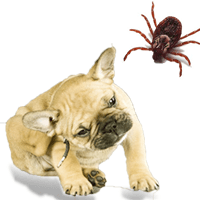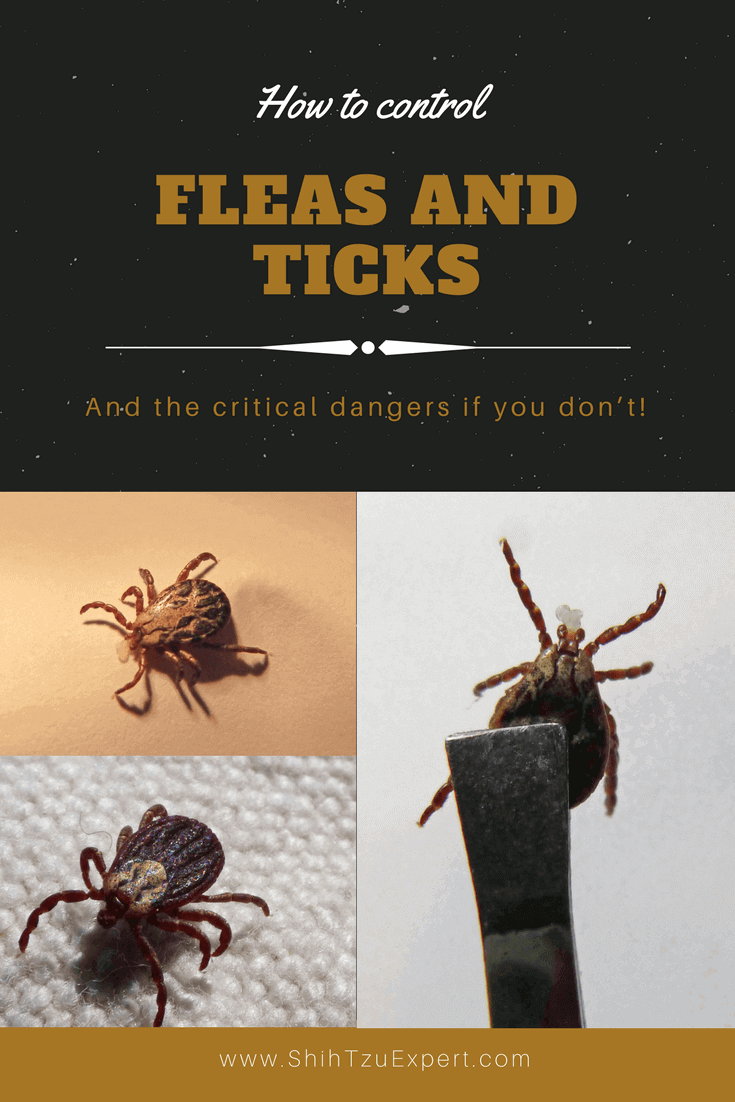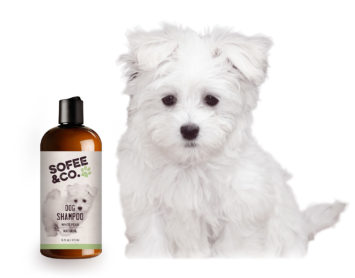
There’s no avoiding it — Fleas and Ticks on Dogs, if your dog goes outside at all, he is going to get fleas in warm climates or at least an occasional tick in just about any geographic area.
The itch of a flea bite or pain of a tick bite are certainly uncomfortable for your pet and for you!, but there is more to watch out for; a proliferation of dog fleas can cause some SERIOUS health problems, as can a single bite from a tick.
As experienced by 1000s of dog owners, this is the most effective solution we have seen so far…
Bayer Seresto Flea and Tick Collar for Dogs [With 8 Months Protection!]
Please visit the article Best Flea Collars for Dogs for a look at the best brands available on the market today!
Fleas and ticks are no picnic for humans, either; bites can cause health problems and an abundance of them in your home can make life unbearable for everyone. Let’s look at some of the resulting health problems from flea and tick bites and what you can do to prevent them.
Dog fleas vs. cat fleas
Surprisingly, there are specific types of fleas that proliferate on dogs which are not the same as those who find cats an ideal host .
The dog flea is distinct from the cat flea in that it has a rounder head and can spread a particular tapeworm called the Dipylidium caninum. Not only can your dog suffer a bout of tapeworms, he can become anemic and suffer severe skin infections, and he can contract an internal bacterial infection called bartonella.
Dog fleas on humans
How to tell if your dog has fleas
The first tell-tale sign that a flea has made himself comfortable on your dog is his itching. You may also notice your dog shake his head or scratch his ears. Just one flea bite alone can cause inflammation of your dog’s skin, and it can cause loss of hair on dogs who are allergic to fleas.

Fleas have no wings; they readily jump from one host to another. You will be able to see fleas moving quickly along the skin of your dog, and over time, a dog with many fleas will also harbor flea eggs and feces, or “flea dirt”, which looks like a group of tiny black specks on the skin. A wet paper towel will dissolve the feces and reveal a stain of digested blood from the flea dirt.
Fleas and Ticks on Dogs – My dog has fleas! What to do now?
So it’s obvious your dog has fleas. Your first strategy is to get the existing fleas off your dog. Your next strategy is to kill all flea eggs in your environment so that the fleas don’t return to your dog — or you.
There is no immediate way to get rid of dog fleas, but there are two effective dog flea treatment options:
- Chemically, with a prescription or topical treatment, or
- more naturally.
Medications and Topical Treatments
Chewable Pills/Tablets vs Subcutaneous Treatments (Frontline) -Advantages & Disadvantages of Each
There are some advantages to the oral medications. Chewable pills may be easier to administer than the topical medications and may not be as irritating to dogs with sensitive skin.
Topical subcutaneous medications may not reach all areas of the dog’s body. Moreover, you should not give your dog a flea bath while using the monthly topical drops. Wait three days after a flea bath before reapplying the monthly topical drops so that the oily layer on your dog’s skin has time to build up again.
Another advantage to subcutaneous treatments is that they are a good alternative for dogs who will do anything not to take a pill.
Dog flea-and-tick control collars
There are some less powerful chemical alternatives to the oral medications and monthly topical drops. Dog flea-and-tick control collars are a preventative, less messy than monthly topical drops, and can be used in conjunction with the monthly drops to provide additional protection.
They can be used and then removed for a later time for special occasions like hikes. Watch for any signs of allergic reaction if you use a flea collar on your dog. Flea-and-tick control collars contain powerful chemicals!
Dog flea-and-tick shampoos
Flea-and-tick shampoos can provide instant soothing relief to your dog while removing fleas immediately. You will need to comb dead fleas off after bathing him, and you will need to shampoo often. With a routine, however, this can be effective.
Other More Natural Options
There are a number of herbal oils available that act as flea repellants, especially around a dog’s legs. Citronella and lavender are among the wide variety. Their aromas can be overwhelming. Find one that suits both you and your dog.
Flea Eggs
Depending on what kind of treatment you are giving your dog, either the adult fleas will be killed but not the eggs, or the eggs will be dried up and destroyed while the adults survive and live out their short life span.
Destroying the eggs is the better long-term option; however, if your dog is allergic to fleas (the saliva), he will still be affected by flea bites. For very allergic dogs, then, the first alternative is the better one.
How to get rid of fleas in the home
You may want to add a chemical treatment as well, such as a fogger, dog flea spray for the home, or other “insect growth inhibitor” to ensure there are no flea eggs. You can purchase these products or have your home professionally cleaned for flea eradication.
Powders can be applied to bedding areas which contain boric acid and limonene. The dust can cause some respiratory irritation but they are effective.
The exterior of your home should be treated with an insect grown inhibitor as well. The chemicals Pyriproxifen and Methoprene are mentioned by PetMD.com; the chemical Chlorpyrifos (Dursban) has been banned by the EPA. There are products available or you can have it done professionally.
Home remedies for fleas
For those who prefer natural options or have dogs or family members with sensitivities, there are several strategies.
Dog flea comb for short hair, long hair, and small dogs
One great routine to adopt every day is the use of a flea comb and a bowl of warm, soapy water. Dog flea combs can be used on short-and long-haired dogs, large and small. Comb through your dog’s coat, and any fleas will get caught in the comb.
Dunk the comb in the sudsy water and make sure all the fleas have been eliminated from the comb. The fleas will not survive in the soapy water.
There are several kinds of plants whose oils repel fleas: sage, rosemary, and mint are the most common. Plant these in your yard and near doors.
Another natural outdoor treatment is to introduce flea-eating nematodes to your yard. There are professionals who can do this for you, and websites for ordering these little superstars if you are up to the task.
Best flea treatment for dogs
Dog ticks
Just about anywhere in the US, and non-mountainous regions of Europe is home to ticks. The websites fleatickrisk.com and cdc.com both offer maps showing the areas most susceptible to flea and tick infestation.
How do dogs get ticks?
Ticks will climb onto dogs (and humans) as they are walking and secure themselves with their mouths with the help of a sticky fluid. The bite alone causes irritation to your dog, and any behavior like localized scratching will be your signal to check for a tick.
Engorged ticks on a dog
If the head is left in, you will need to visit the vet to ensure that the bacteria it transmits does not cause an illness in your dog. These illnesses include anemia and tick fever, which requires antibiotics. Please see our article on “Dog Fever” for more information.
How to remove a tick: dog tick remover
There are special kits made just for removing ticks from dogs. They make it easier to be able to remove the entire tick from a dog and not leave the head or mouth parts behind.
If your dog is covered in ticks
The most powerful method is a tick “dip”: a strong chemical treatment that should not be used on sensitive dogs, puppies or pregnant and nursing dogs.
Combining flea and tick prevention
If you live in an area where both fleas and ticks are prevalent, you will want to consider products like flea-and-tick collars, and combinations of oral and topical medications that kill both.
The good news is that there is an outstanding array of products available to prevent flea and tick infestations both on your dog and in and around your home. These products can be used alone or in combination with other products as prescribed by your vet to give you the best defense against these common pests.
Natural Flea and Tick Prevention
There are many great products on the market that will remove fleas and ticks from your pet, but if you you’re looking for a more natural method, there are several ways to do this.
Submerging your dog in water
The first thing you’ll want to do is give your dog a good bath. Simply submerging your dog in water will not work as the fleas can get caught in air bubbles that are trapped in the fur. Dawn dishwashing detergent works very well in suffocating the fleas. Prior to bathing, manually search through your dog’s coat. Check in his ears and between his paws and on his tail and remove and kill as many fleas as possible. After you bathe your pet, search his body again in case any fleas survived and kill them.
A 50/50 mixture of apple cider vinegar (ACV) and water can be sprayed on your dog’s coat before he goes outside. This will act as a natural deterrent for pests. You can add a quart of distilled vinegar to your dog’s bath water. Don’t towel dry your dog, let him air dry for best results. Some pet owners have claimed to have great success in adding a few drops of vinegar to their dog’s drinking water as well. It’s non-toxic for the dog but is said to make their blood and skin unpleasant for the fleas. Do not let a cat ingest ACV as it is too acidic for them.
Coconut oil
Lauric acid, an ingredient found in coconut oil can also be used to repel fleas. Because coconut oil melts at 76 degrees, you can simply rub it between your hands and then rub it through your dog’s coat. As an added bonus, coconut oil makes a great moisturizer for your dog’s skin and it helps to kill yeast as well. You can also add the coconut oil to your pet’s food. Simply add 1 teaspoon for every 20 pounds of your dog’s weight twice a day.
Fresh crushed garlic
There are some who believe that fresh crushed garlic can be used as a flea deterrent on dogs. But be very cautious as garlic can be deadly for dogs. If you are going to use garlic, please be very careful and use no more than ½ clove of garlic per 20 pounds of your dog’s body weight daily. Do not exceed 2 cloves of garlic. If you have a pet that has a history of hemolytic anemia, then do not give them garlic, and do not give cats any garlic at all. They are more sensitive to the toxic effects.
Diatomaceous earth
Another organic option for pest control is diatomaceous earth. Diatomaceous earth is non-toxic to pets and humans but try not to breath in the powder and you don’t want to get it in your eyes. Simply shake it on your dog and brush it through his fur. Make sure to sprinkle it in the dog’s bedding as well.


![Custom shape wireless dog fence [Electric Fencing and Electric Barrier Systems] Custom shape wireless dog fence [Electric Fencing and Electric Barrier Systems]](https://shihtzuexpert.com/wp-content/uploads/2019/07/Custom-Shape-Wireless-Dog-Fence-Review.png)


